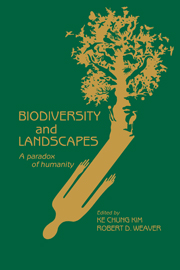Book contents
- Frontmatter
- Contents
- Contributors
- Preface
- Part I Introduction
- Part II Human values and biodiversity
- Part III Human processes and biodiversity
- Part IV Management of biodiversity and landscapes
- Part V Socioeconomics of biodiversity
- Part VI Strategies for biodiversity conservation
- 16 Market-based economic development and biodiversity: an assessment of conflict
- 17 Technology and biodiversity conservation: are they incompatible?
- 18 “Emergy” evaluation of biodiversity for ecological engineering
- 19 Urban horticulture: a part of the biodiversity picture
- 20 The watchdog role of nongovernmental environmental organizations
- 21 Legislative and public agency initiatives in ecosystem and biodiversity conservation
- Part VII Biodiversity and landscapes: postscript
- Index
16 - Market-based economic development and biodiversity: an assessment of conflict
Published online by Cambridge University Press: 04 August 2010
- Frontmatter
- Contents
- Contributors
- Preface
- Part I Introduction
- Part II Human values and biodiversity
- Part III Human processes and biodiversity
- Part IV Management of biodiversity and landscapes
- Part V Socioeconomics of biodiversity
- Part VI Strategies for biodiversity conservation
- 16 Market-based economic development and biodiversity: an assessment of conflict
- 17 Technology and biodiversity conservation: are they incompatible?
- 18 “Emergy” evaluation of biodiversity for ecological engineering
- 19 Urban horticulture: a part of the biodiversity picture
- 20 The watchdog role of nongovernmental environmental organizations
- 21 Legislative and public agency initiatives in ecosystem and biodiversity conservation
- Part VII Biodiversity and landscapes: postscript
- Index
Summary
Introduction
The conflict between market driven economic activity and the environment would seem to be a broadly accepted fact. The conflict is so generally perceived that the feature film “The Medicine Man” symbolizes the conflict graphically with scenes of bulldozers devastating an Amazonian rainforest defended by a field biochemist seeking a cure for cancer in the treetops of the forest. When I saw this film, the audience quietly watched, apparently accepting the validity of this dramatic illustration of the impacts of economic activity on biodiversity and the environment. The same logic is also apparently accepted for urban development, which in the developed world is often viewed as posing a threat to remaining grasslands, forests, and wetlands.
These images provide a view of the paradoxical conflict facing humanity that has been raised throughout this volume. The conflict can be summarized as follows. Extinction of species is occurring at a substantially greater rate today relative to past periods (Myers, 1994). This high extinction rate is due in part to human economic activity and development and the associated pressures, e.g., population growth (Holdgate, 1989), resource extraction (Soule & Wilcox, 1980), and waste disposal (World Bank, 1992), placed on limited resources and ecologies. The extinction process is of such magnitude that many conclude it may threaten human life itself (Myers, 1988: Raven, 1988). Thus, the paradox is that humans depend for survival on biodiversity, nature, and ecological resources that are subsumed in landscapes, yet, at the same time, human survival apparently threatens the survival or existence of those very resources.
- Type
- Chapter
- Information
- Biodiversity and LandscapesA Paradox of Humanity, pp. 307 - 326Publisher: Cambridge University PressPrint publication year: 1994

